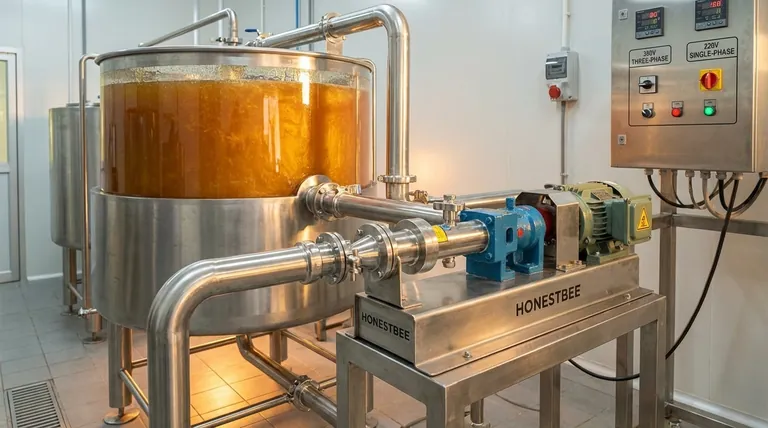In short, stainless steel screw honey pumps are typically available in two standard voltage configurations. These are 220V for single-phase power, common in smaller or residential settings, and 380V for three-phase power, which is standard in most industrial and commercial facilities.
The choice between 220V and 380V is not merely about what plug you have available; it is fundamentally a decision about the scale of your operation and the power required to meet your production demands.

Why Voltage is a Critical Decision
Choosing the correct voltage is the first step in matching the pump's motor to your electrical infrastructure and your operational needs. Getting this wrong can lead to equipment damage, inefficiency, or the need for costly electrical work.
Understanding 220V (Single-Phase)
Single-phase power is the standard electrical service found in homes and small workshops.
A 220V pump is ideal for smaller-scale operations, such as those run by hobbyists or boutique apiaries. It offers convenience by using existing, common electrical outlets without needing specialized wiring.
Understanding 380V (Three-Phase)
Three-phase power is the workhorse of commercial and industrial environments. It delivers power more efficiently and smoothly.
A 380V pump is designed for larger, more demanding production environments. These motors are generally more robust, efficient, and have a longer service life under continuous, heavy use.
The Link Between Voltage, Power, and Capacity
The voltage choice is directly tied to the pump's motor size, which in turn determines its processing capacity—how much honey it can move per hour.
For Lower Capacity Needs (e.g., 1T/H)
Pumps with a capacity around 1 ton per hour (1T/H) are often available in 220V single-phase configurations. This capacity is well-suited for smaller producers where high-volume processing is not the primary goal.
For Higher Capacity Needs (e.g., 3T/H to 5T/H)
Pumps designed to move 3 to 5 tons per hour (3T/H, 5T/H) almost exclusively require 380V three-phase power.
The larger motors needed to achieve this throughput demand the efficiency and stability that only three-phase power can provide. Attempting to run such a large motor on a single-phase system would be highly inefficient and impractical.
Understanding the Trade-offs
Choosing the right voltage requires acknowledging the practical limitations and benefits of your electrical system.
The Simplicity of 220V
The primary advantage of a 220V pump is its plug-and-play nature in non-industrial settings. It avoids the need for professional electrical installation that three-phase power requires.
However, these systems are less efficient for high-power motors and are generally limited to smaller-capacity equipment.
The Industrial Power of 380V
The main benefit of a 380V system is its power and efficiency for demanding tasks. It allows for larger, more durable motors that can run continuously without strain.
The trade-off is the requirement for a facility with existing three-phase electrical service, which is not typical outside of commercial or industrial zones.
Making the Right Choice for Your Goal
To select the correct pump, evaluate your operational scale and your facility's electrical capabilities.
- If your primary focus is small-batch or hobbyist production: A 220V single-phase pump is the most practical and cost-effective choice.
- If your primary focus is commercial or industrial-scale processing: A 380V three-phase pump is essential for achieving the necessary throughput and operational efficiency.
Ultimately, aligning the pump's voltage with your production capacity ensures safe, efficient, and reliable operation.
Summary Table:
| Voltage | Phase | Ideal For | Typical Capacity Range |
|---|---|---|---|
| 220V | Single-Phase | Hobbyists, Boutique Apiaries | Up to ~1T/H |
| 380V | Three-Phase | Commercial & Industrial Operations | 3T/H to 5T/H+ |
Upgrade Your Honey Processing Efficiency with HONESTBEE
Choosing the right voltage for your honey pump is crucial for your operation's success. As a leading wholesale supplier of commercial beekeeping equipment, HONESTBEE provides durable, high-performance stainless steel screw honey pumps in both 220V and 380V configurations. We help commercial apiaries and distributors optimize their workflow with equipment built for reliability and high-volume output.
Let our experts guide you to the perfect pump for your electrical infrastructure and capacity needs. Contact HONESTBEE today for wholesale pricing and technical support!
Visual Guide

Related Products
- Honey Convey Pump Screw Honey Pump for Viscous Liquid
- 10L Stainless Steel Electric Honey Press Machine
- Stainless Steel Manual Honey Press with Guard for Pressing Honey and Wax
- HONESTBEE 6 Frame Three Use Electric Honey Extractor for Beekeeping
- electric honey extractor honey centrifuge 3 frame honey extractor stainless steel honey frame extractor
People Also Ask
- What types of pumps are available for honey processing? Choose the Right Pump to Protect Honey Quality
- What are the benefits of the screw design in a stainless steel honey pump? Preserve Honey Quality and Integrity
- What is a stainless steel screw honey pump used for? A Guide to Gentle, Efficient Honey Transfer
- Where are stainless steel screw honey pumps commonly used? In Commercial Honey Processing & Quality-Focused Operations
- How does a stainless steel screw honey pump operate? A Guide to Gentle, High-Quality Honey Transfer



















